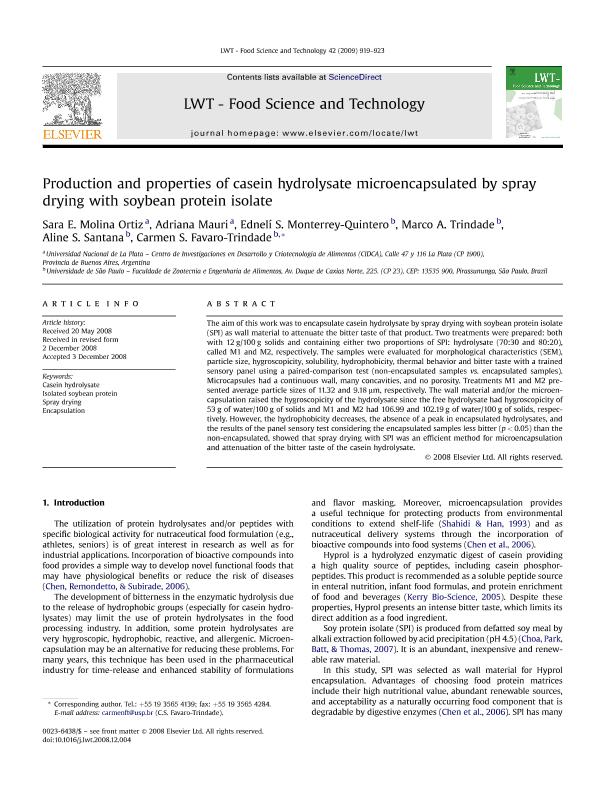Artículo
Production and properties of casein hydrolysate microencapsulated by spray drying with soybean protein isolate
Molina Ortiz, Sara Eugenia; Mauri, Adriana Noemi ; Monterrey Quintero, Ednelí S.; Trindade, Marco A.; Santana, Aline S.; Favaro Trindade C.S.
; Monterrey Quintero, Ednelí S.; Trindade, Marco A.; Santana, Aline S.; Favaro Trindade C.S.
 ; Monterrey Quintero, Ednelí S.; Trindade, Marco A.; Santana, Aline S.; Favaro Trindade C.S.
; Monterrey Quintero, Ednelí S.; Trindade, Marco A.; Santana, Aline S.; Favaro Trindade C.S.
Fecha de publicación:
06/2009
Editorial:
Elsevier Science
Revista:
LWT - Food Science and Technology
ISSN:
0023-6438
e-ISSN:
1096-1127
Idioma:
Inglés
Tipo de recurso:
Artículo publicado
Clasificación temática:
Resumen
The aim of this work was to encapsulate casein hydrolysate by spray drying with soybean protein isolate (SPI) as wall material to attenuate the bitter taste of that product. Two treatments were prepared: both with 12 g/100 g solids and containing either two proportions of SPI: hydrolysate (70:30 and 80:20), called M1 and M2, respectively. The samples were evaluated for morphological characteristics (SEM), particle size, hygroscopicity, solubility, hydrophobicity, thermal behavior and bitter taste with a trained sensory panel using a paired-comparison test (non-encapsulated samples vs. encapsulated samples). Microcapsules had a continuous wall, many concavities, and no porosity. Treatments M1 and M2 presented average particle sizes of 11.32 and 9.18 mm, respectively. The wall material and/or the microencapsulation raised the hygroscopicity of the hydrolysate since the free hydrolysate had hygroscopicity of 53 g of water/100 g of solids and M1 and M2 had 106.99 and 102.19 g of water/100 g of solids, respectively. However, the hydrophobicity decreases, the absence of a peak in encapsulated hydrolysates, and the results of the panel sensory test considering the encapsulated samples less bitter (p < 0.05) than the non-encapsulated, showed that spray drying with SPI was an efficient method for microencapsulation and attenuation of the bitter taste of the casein hydrolysate.
Palabras clave:
CASEIN HYDROLYSATE
,
ENCAPSULATION
,
ISOLATED SOYBEAN PROTEIN
,
SPRAY DRYING
Archivos asociados
Licencia
Identificadores
Colecciones
Articulos(CIDCA)
Articulos de CENTRO DE INV EN CRIOTECNOLOGIA DE ALIMENTOS (I)
Articulos de CENTRO DE INV EN CRIOTECNOLOGIA DE ALIMENTOS (I)
Citación
Molina Ortiz, Sara Eugenia; Mauri, Adriana Noemi; Monterrey Quintero, Ednelí S.; Trindade, Marco A.; Santana, Aline S.; et al.; Production and properties of casein hydrolysate microencapsulated by spray drying with soybean protein isolate; Elsevier Science; LWT - Food Science and Technology; 42; 5; 6-2009; 919-923
Compartir
Altmétricas



